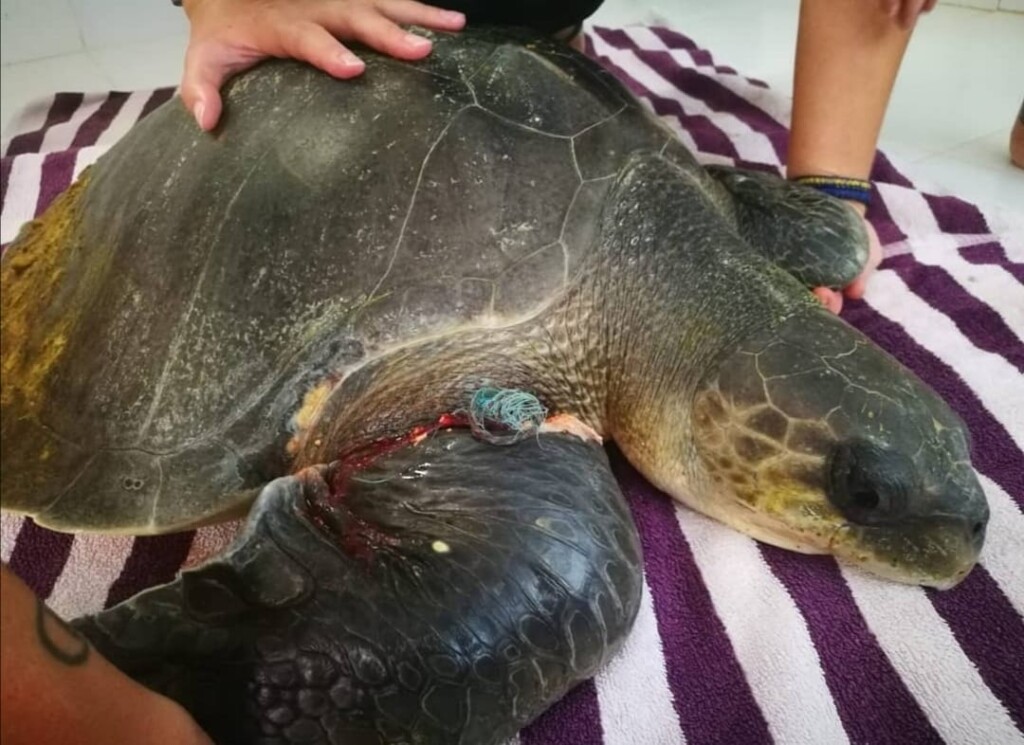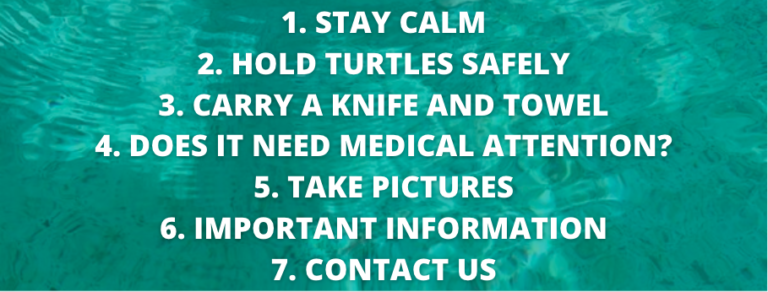If you have come across an injured sea turtle that is in need of emergency medical services, please contact Atoll Marine Centre:
Email us at marine@naifarujuvenile.org
Call us at (+960)7434782

How to Deal With Injured Sea Turtles
Unfortunately the ocean is full of debris, which can be dangerous to sea life. Turtles often get caught in ghost nets that have been discarded by neighboring countries. Cement bags, plastic bags, and fishing lines are just some of the things that are discarded in the ocean. Turtles often approach debris in hopes of finding food and shelter. Olive Ridley turtles are most commonly caught.
This guide explains what to do if you come across an injured sea turtle whilst on a boat.

1 – STAY CALM
It is easy to panic when you see a stranded turtle at sea as it can be very stressful. It is important to stay calm. The turtle has probably been entangled or trapped for hours so there is no rush to get it out. The main priority is rescuing the turtle safely, even if it takes longer than expected.
2 – HOLD TURTLES SAFELY
When lifting the turtle out of the water, carry the turtle by the shell if it is larger and under the armpits if small. Turtles are stronger than they look so be careful of their beaks, claws and strong fins.
3 – CARRY A KNIFE AND TOWEL
Turtles are often floating along with the debris usually because of buoyancy syndrome. When coming across the turtle(s), it is important to not pull them out of the water by the net, but to bring the turtle out by handling the turtle itself. If they are caught in a big net, or there are multiple turtles in there, you will need to get in the water and cut the debris around the turtle. Do not remove the debris from any wounds on the turtle. Always carry a knife and a towel on board your boat. Once the turtle is out of the water you can wrap it in a towel. Turtles are strong enough to break their own fins so wrapping them in a towel will ensure they stay calm and are restrained. If the turtle is not in a box or towel and is moving a lot, you can place them on their back (last resort if injured). Cover their eyes with a wet towel to keep them calm, keep nostrils free.
4 – DOES IT NEED MEDICAL ATTENTION?
Once out of the water, examine the turtle. If you think the net is holding blood and is keeping the turtle from losing too much blood, leave the net in the wound and focus on getting the turtle to your nearest marine centre. If you think the net hasn’t cut into the turtle then cut the ghost net off. Check if the turtle has injuries that need medical attention. If the turtle has a damaged carapace, sunken eyes, severe wounds, or swollen fins it needs medical attention from the vet. If the carapace is slightly damaged or is scabbing and starting to heal it does not need medical attention.
5 – TAKE PICTURES
If possible, take pictures of the entire process. The net/debris that it was caught in, the turtle caught in the net for awareness, either side of the turtle’s face for identification and the turtle’s carapace.
6 – IMPORTANT INFORMATION
Take note of the location the turtle was found, note down what species of turtle, how many were caught and if there was anything else caught in the net. You can email all of this information to marine@naifarujuvenile.com
7 – CONTACT US
If you are on a boat and are able to take the turtle to your nearest Marine Centre that would be ideal. There is Atoll Marine Centre 7434782, The Olive Ridley Project 9552205 and Marine Savers 6600888. Wrap the turtle in a towel and put in a box if possible.

